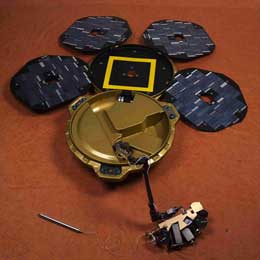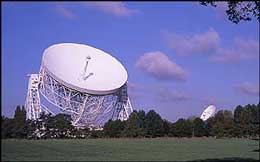 |
| The Beagle 2 Lander |
LONDON, England (AP) -- Though space
scientists have failed in two more attempts to confirm
if Europe's first probe to Mars had safely reached the
red planet, officials maintain they still haven't given
up hope.
The efforts Friday by a NASA
spacecraft and later by a British observatory were the
third and fourth attempts to track the tiny Beagle 2
lander, since it was to have arrived on Mars shortly
before 0300 GMT Thursday.
The probe -- designed to search for
signs of life -- should have opened its solar panels and
called home within a few hours. That didn't occur and
scientists have trying ever since to locate it.
NASA's Mars Odyssey, which has been in
orbit since 2001, had the first shot at communicating
early on Thursday, but picked up nothing.
 |
| Jodrell Bank Radio Telescope |
A powerful radio telescope at the
Jodrell Bank Observatory in Cheshire, England, also
failed to detect Beagle's call sign, despite scanning
the Martian surface late Thursday.
On Friday, the NASA craft swept over
the planned touch-down site on the Red Planet without
picking up a signal. Friday evening, Jodrell scientists
zeroed in on the planet again but with no luck.
The Stanford University radio
telescope in California might be able to listen on
Saturday, the agency said.
There was no immediate comment from
the European Space Agency scientists Friday evening. But
they had faced the first two failures with confidence
and optimism, insisting it was too early to lose heart.
"We are not in any way giving up
yet," Colin Pillinger, chief Beagle scientist, said
at a news conference earlier in the day. "We will
hang on testing and waiting and checking with Beagle 2
until Mars Express is able to look for us and that won't
happen until Jan. 4."
 |
| The Beagle 2 on the Russian Soyuz rocket
prior to launch |
The Mars Express mother ship, which
carried Beagle into space and set it loose a week ago,
could offer the best chance to get a signal from Beagle.
The mother ship, which went into orbit
around Mars on Thursday, is designed to beam back data
gathered by Beagle. In the coming days, controllers must
change its orbit from a high elliptical one around the
equator to a lower polar orbit that will let it
establish contact with Beagle.
Unlike Odyssey and the Jodrell
telescope, its communications were specifically designed
to hear the probe's transmissions, Pillinger said.
Pillinger said both the Mars Odyssey
link and communications using Jodrell Bank were
untested, but there were several more chances for
Odyssey to pick up a Beagle signal. The next occurs at
around 0700 GMT Saturday when Mars Odyssey passes over
the landing site again.
After that the lander will go into an
auto transmit mode, sending out a continuous on-off
pulse throughout the Martian daylight hours to anyone
able to receive it, the agency said.
Possible explanations for Beagle's
failure to call home include an off-course landing in an
area where communication with Mars Odyssey was
difficult, if not impossible. Or transmission from the
lander's antenna could be blocked from reaching Mars
Odyssey or the ground-based telescopes, the agency said.
Despite the concerns, European
Research Commissioner Philippe Busquin said the mission
is a "fantastic achievement," whether
scientists get any transmissions from the Beagle 2 craft
or not. (Mars
Express success)
"Even if not all parts of the
mission have succeeded, we must still acknowledge its
significance, and build upon the experience gained to
ensure higher chances of success in the future,"
the European Union official said in Brussels.
|